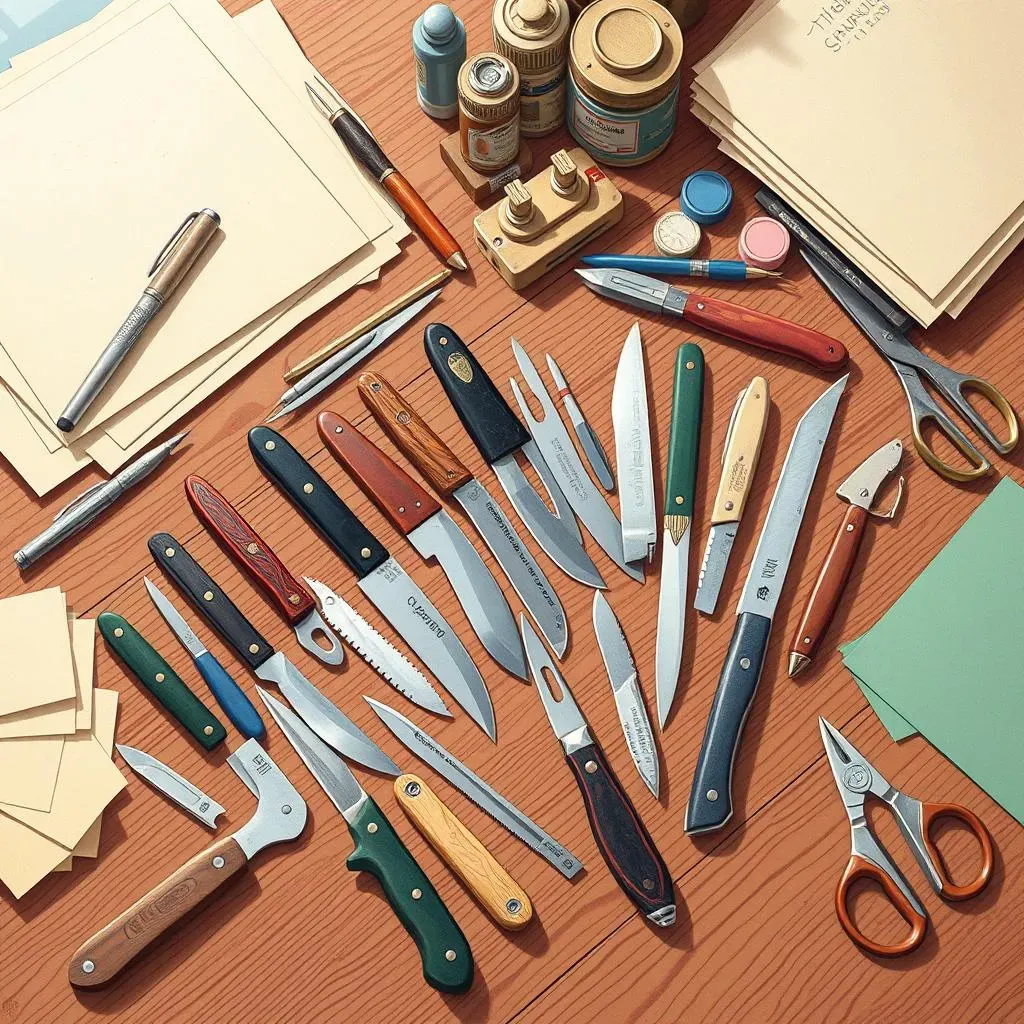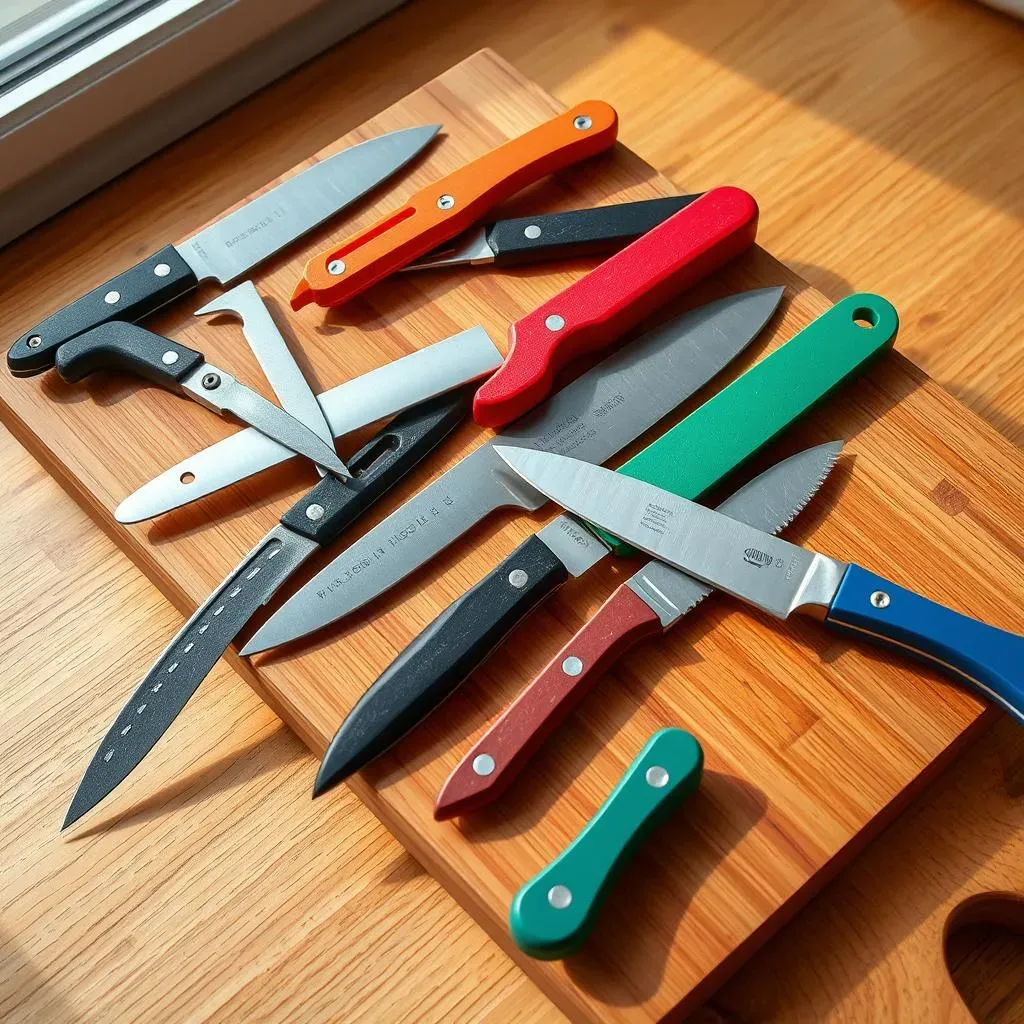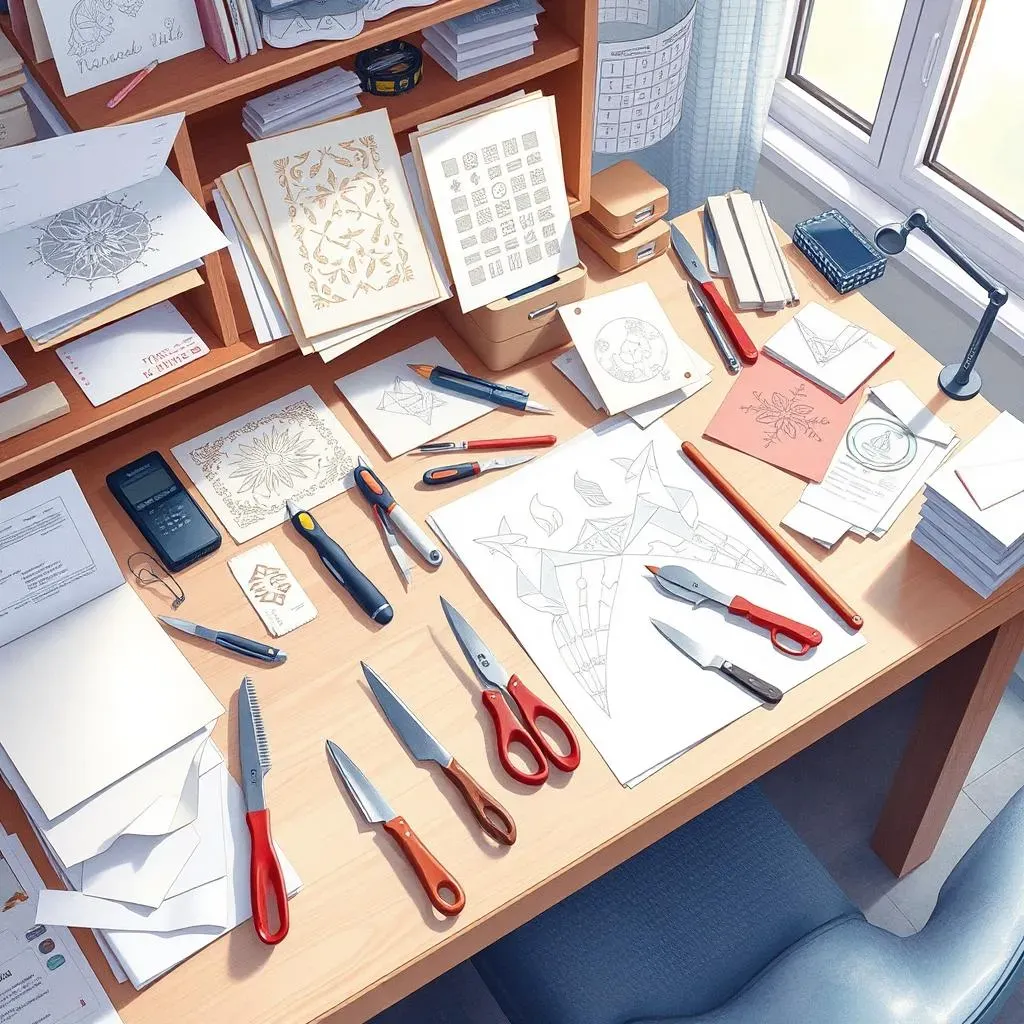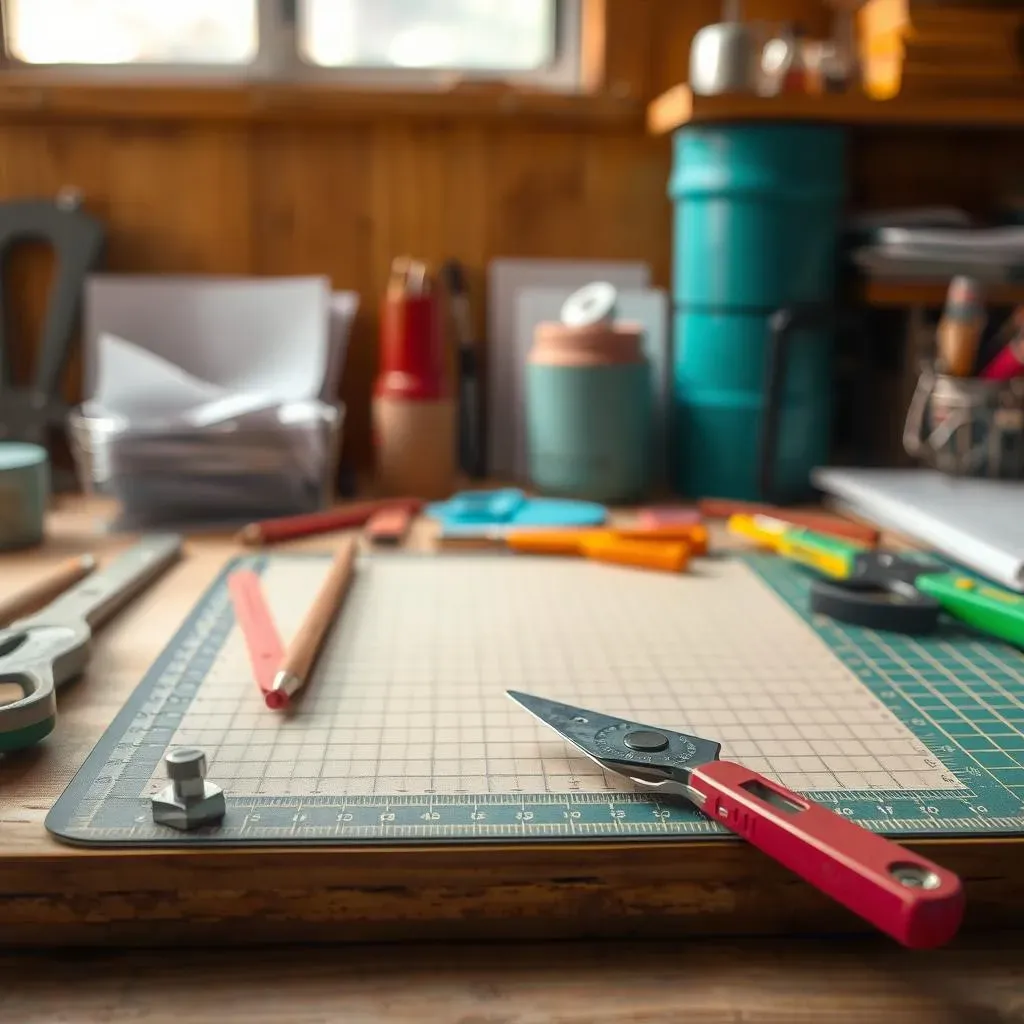Table of Contents
Ever stared at a drawer full of blades and wondered, "What's the deal with all these paper cutting knife names?" You're not alone. Whether you're a seasoned crafter or just starting out, picking the right tool can be confusing. This article will cut through the jargon and get straight to the point. We'll explore the different types of paper cutting knives, from the trusty craft knife to the more specialized rotary cutter. You'll learn what each one is best for, helping you make the right choice for your projects. Forget about frustrating snags and uneven edges. We'll show you how to choose the perfect "paper cutting knife name" for your needs, ensuring clean, precise, and satisfying results. So, grab a cup of tea, and let's get cutting!
Crafting with Precision: Understanding Paper Cutting Knife Names
Crafting with Precision: Understanding Paper Cutting Knife Names
Okay, so you're diving into the world of paper crafting, that's fantastic! But then, you see all these different knives with fancy names. It's like, "Whoa, what's a stencil knife versus a swivel knife?" Honestly, it can feel like learning a whole new language. Don't sweat it, though. It's simpler than it looks. Basically, each name tells you a little bit about what the knife is designed to do. Some are made for super detailed work, others for cutting straight lines, and some for those cool curves. Understanding these names is the first step in choosing the right tool for the job. Think of it like this: you wouldn't use a butter knife to carve a roast, right? Same deal with paper knives, each has its own best use case. Let’s break it down, no fancy terms needed.
Finding Your Perfect Match: Types of Paper Cutting Knives
Finding Your Perfect Match: Types of Paper Cutting Knives
Alright, let's get into the fun part, the different kinds of paper cutting knives. It's like choosing your superpower, but for paper! First up, we've got the classic craft knife. This is your all-around player, like the Swiss Army knife of paper cutting. Then there's the medium-duty knife, which is a bit beefier for thicker stuff. Think cardstock and those stubborn bits of cardboard. Now, if you're into fancy curves, you'll need a swivel knife. It's like the figure skater of the knife world, gliding through those rounded shapes with ease. And, for those of you who love stencils, there's, yep, the stencil knife. It's lightweight and precise, perfect for those intricate designs.
And it doesn't stop there, you know? If you are working on straight lines, then dual blade strip cutters are a life saver, they cut clean strips every time. For those of you who are working with cardboard or cardstock, snap blade knives are the way to go. They are easy to use and you can just snap of the blade to get a fresh sharp edge. Now for the big guns, the utility knives, these are the workhorses for heavier duty cutting. And finally, the rotary cutter, think of it like a pizza cutter for fabric and paper. It's fantastic for long, smooth cuts and a real favorite for quilters and artists. So, as you can see, there's a knife for pretty much every kind of cutting job you can imagine.
Knife Type | Best For |
|---|---|
Craft Knife | General, detailed cutting |
Medium-Duty Knife | Thicker materials |
Swivel Knife | Curves and circles |
Stencil Knife | Stencils and precision work |
Dual Blade Strip Cutters | Cutting strips |
Snap Blade Knives | Cardboard and cardstock |
Utility Knives | Heavy-duty cutting |
Rotary Cutters | Long, smooth cuts |
Paper Cutting Knife Names: Which Tool for Which Task?
Paper Cutting Knife Names: Which Tool for Which Task?
Matching the Knife to the Job
Okay, so now you know the names, but how do you actually pick the right knife for your project? It's like choosing the right brush for painting; the tool makes a huge difference. If you're doing some intricate paper art, like those crazy detailed paper snowflakes, a craft knife or a stencil knife will be your best friends. They offer the precision you need to cut those tiny corners and curves. On the other hand, if you're cutting out shapes from thicker cardstock for a greeting card, you'll want to grab that medium-duty knife or even a snap blade knife. They're stronger and can handle the extra resistance. It's all about understanding what each knife is good at.
And let's not forget about those long, straight cuts. If you're making banners or cutting strips for a collage, a dual blade strip cutter or a rotary cutter will save you a ton of time and frustration. No more wobbly lines! And if you're working with a stencil, that's where the stencil knife shines. It's all about precision and control. So, think about the kind of cuts you need to make, and then pick the knife that's best suited for that task. It's like a puzzle, matching the right tool to the right job.
Real-World Examples
Let’s make this less abstract with some real-world examples. Imagine you're making a paper model of a car. For the body, you might use a medium-duty knife to cut out the main shapes from cardstock. But for the intricate details, like the windows or the grill, a craft knife would be your go-to. Now, if you’re making a scrapbook and want to create those long, decorative borders, a rotary cutter would be perfect for making those long, smooth cuts. Or, let's say you're making a stencil for a wall art project, you will reach out for the stencil knife, and that will make the process much easier and more precise. Thinking about it this way, you can see how each paper cutting knife has its own special place.
It's also helpful to remember that it's okay to use multiple knives in one project. You don’t have to be loyal to one. In fact, most crafters have a whole collection of different paper cutting knives that they choose from. It's all about having the right tool at your fingertips. And don't be afraid to experiment! Try out different knives on scrap pieces of paper to see which one feels the most comfortable and gives you the best results for each type of cut. It's like finding your favorite pair of shoes; it takes a bit of trying to find the perfect fit.
Project | Recommended Knife |
|---|---|
Intricate Paper Art | Craft Knife, Stencil Knife |
Card Making | Medium-Duty Knife, Snap Blade Knife |
Long Strips or Banners | Dual Blade Strip Cutter, Rotary Cutter |
Stencils | Stencil Knife |
Paper Models | Combination of Craft Knife and Medium-Duty Knife |
Scrapbooking | Rotary Cutter |
Beyond the Blade: Essential Paper Cutting Tools
Beyond the Blade: Essential Paper Cutting Tools
The Cutting Mat: Your Best Friend
Okay, so you've got your knives sorted, but don't think that's all you need! A good cutting mat is an absolute must-have. It's like the stage for your performance; you wouldn't dance on a rocky surface, would you? A self-healing cutting mat protects your work surface and your blades. Without it, you'll end up with nicks and scratches all over your desk, and your knife blades will dull super fast. Trust me, a cutting mat is an investment that will pay off big time. It provides a smooth, even surface that makes cutting easier, safer, and more precise. Plus, it saves your furniture from looking like a battleground. They come in all sizes so you can find one that fits your work area, big or small.
I remember when I started out, I thought, "Oh, I can just use a piece of cardboard." Big mistake! I ended up with a ruined table and a very frustrated me. A proper cutting mat not only saves your furniture but also has measurement grids on it, which is a fantastic bonus. These grids help you make accurate cuts and ensure everything is straight and aligned. Think of it as having a built-in ruler right there on your work surface, making your life so much easier. It might seem like a basic thing, but a good cutting mat is a game-changer for paper crafting and is essential to any toolkit.
Rulers and Guides: Straighten Up Your Cuts
Next up, let’s talk about rulers and guides. You might think, "Oh, I can just eyeball it," but trust me, you can't always do that. A good metal ruler is essential for making straight cuts. The metal edge acts as a guide for your knife, ensuring that your lines are clean and precise. Plastic rulers can get nicked and warped, so it's best to invest in a sturdy metal one. I remember trying to cut a straight line with a plastic ruler, and it ended up looking like a mountain range. A metal ruler is your friend when you need those crisp, clean edges.
And don't forget about guides! You can use stencils, templates, or even just a piece of cardboard to help you cut out shapes and patterns. Guides are great for those repetitive cuts, like making multiple shapes for a collage or a scrapbook layout. They save you time and energy and ensure that each cut is consistent. And let’s not forget about templates for those of you who love to make greeting cards, they are a great way to make sure your cuts are perfect every time. The right rulers and guides are like a GPS system for your knife, helping you navigate the paper with precision and ease. They make the whole cutting process so much smoother and more enjoyable.
Tool | Purpose |
|---|---|
Cutting Mat | Protects surfaces, extends blade life |
Metal Ruler | Provides a straight edge for cuts |
Templates and Stencils | Guides for shapes and patterns |
Cutting It Short: Choosing Your Perfect Blade
So, there you have it. Navigating the world of paper cutting knife names doesn't have to be a chore. From the nimble stencil knife to the sturdy utility blade, each tool has its own special purpose. By understanding these differences, you can choose the right knife for your next project, whether you're crafting intricate paper art or just need to open a particularly stubborn package. Remember, the best knife is the one that feels comfortable in your hand and gives you the results you're after. Now go forth and create something amazing!